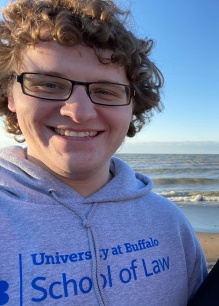Up the creek, armed with knowledge
Information is power, and Western New Yorkers who kayak on, stroll along or live near Scajaquada Creek—a 13-mile stream that runs from the Town of Lancaster to the Niagara River—will be more informed and more effective because of one law student’s work.

Nicholas Pistory ’21 visiting Presque Isle State Park in his hometown, Erie, PA.
Read “The Lower Scajaquada Creek: Empowering Communities Through Historical and Legal Analysis.”
Nicholas Pistory ’21 spent last summer researching and creating an environmental law and policy resource guide titled “The Lower Scajaquada Creek: Empowering Communities Through Historical and Legal Analysis.” With beautiful pictures of the waterway and sections on its history and the bodies of law that regulate it, it’s a one-stop resource for anyone who wants to see the creek become a gem of Buffalo’s urban ecosystem.
“The best outcome for this document,” Pistory says, “is someone using it to help them have a voice in how the creek and the lands next to it can be utilized to positively affect everyone, whether you live a block from the creek or you walk your dog on the path next to it. The hope is to have uses that are beneficial to people but simultaneously don’t disturb the naturalness of the creek.”
He researched and created the project as an intern for New York Sea Grant, which sponsors university-based programs to inform decision-making about the state’s coastlines, under a grant from the National Sea Grant Law Center. His internship colleagues included students from law schools at the City University of New York and Pace University, both of whom focused on downstate coastal issues.
The resulting resource, in a format called a Story Map, begins, “The Scajaquada Creek is important because of its potential for revitalization. With recent revitalization along other waterways in Buffalo, such as the Buffalo River, the Scajaquada Creek could be the next location of local waterway revitalization."
Pistory then provides a concise history of the waterway, noting that its mouth on the Niagara River was home to a Navy shipyard during the War of 1812 that helped recondition Commodore Perry’s ships, and that the creek was partly dammed to accommodate Frederick Law Olmsted’s design for Delaware Park.
But the bulk of the resource educates users on laws and codes that regulate use of the creek: the binational Great Lakes Water Quality Agreement, Buffalo’s Local Waterfront Revitalization Plan and the Buffalo Green Code. “There’s a lot of play between the different laws,” Pistory says. “Being a law student, I know how to find these types of documents, but even I had trouble finding the Green Code and the LWRP. I wanted to make these resources more easily accessible,” so they’re linked within the Story Map.
There are also practical steps users can take to get involved, showing, for example, how to initiate an amendment to the Green Code. “The goal was to help educate the community on how they can play a role in how their waterways are utilized and impacted,” he says.
“This type of project is an excellent win-win-win service learning opportunity,” says Professor Kim Diana Connolly, who directs UB Law’s Environmental Law Clinic. “Students, like Nic, get great experience by producing valuable work for our community and providing community members with information to help them become better stewards of New York’s shoreline ecosystems. And Sea Grant receives work products that can be shared within their network and beyond.
“It was an honor to work with NY Sea Grant to secure the legal capacity-building grants from the National Sea Grant Law Center,” she adds. “And it was so gratifying to see the success of this initiative last summer.”
For Pistory, an avid kayaker who completed the law school’s environmental law concentration, the project was an exercise in imagination. Because of Covid restrictions in effect last summer, he executed the project from his home in Erie, Pa., without ever actually laying eyes on Scajaquada Creek. “Once all this is lifted,” he says, “I’d love to go down there and see it.”